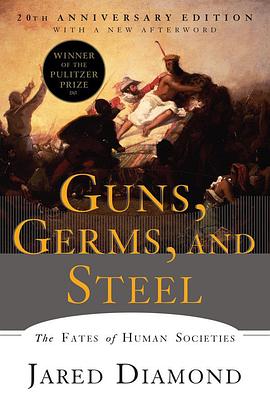Guns, Germs, and Steel
豆瓣
The Fates of Human Societies
Jared Diamond
简介
Winner of the Pulitzer Prize • New York Times Bestseller • Over Two Million Copies Sold
“One of the most significant projects embarked upon by any intellectual of our generation” (Gregg Easterbrook, New York Times), Guns, Germs, and Steel presents a groundbreaking, unified narrative of human history.
Why did Eurasians conquer, displace, or decimate Native Americans, Australians, and Africans, instead of the reverse? In this “artful, informative, and delightful” (William H. McNeill, New York Review of Books) book, a classic of our time, evolutionary biologist Jared Diamond dismantles racist theories of human history by revealing the environmental factors actually responsible for its broadest patterns.
The story begins 13,000 years ago, when Stone Age hunter-gatherers constituted the entire human population. Around that time, the developmental paths of human societies on different continents began to diverge greatly. Early domestication of wild plants and animals in the Fertile Crescent, China, Mesoamerica, the Andes, and other areas gave peoples of those regions a head start at a new way of life. But the localized origins of farming and herding proved to be only part of the explanation for their differing fates. The unequal rates at which food production spread from those initial centers were influenced by other features of climate and geography, including the disparate sizes, locations, and even shapes of the continents. Only societies that moved away from the hunter-gatherer stage went on to develop writing, technology, government, and organized religions as well as deadly germs and potent weapons of war. It was those societies, adventuring on sea and land, that invaded others, decimating native inhabitants through slaughter and the spread of disease.
A major landmark in our understanding of human societies, Guns, Germs, and Steel chronicles the way in which the modern world, and its inequalities, came to be.
Review
"Artful, informative, and delightful.... There is nothing like a radically new angle of vision for bringing out unsuspected dimensions of a subject, and that is what Jared Diamond has done."
― William H. McNeil, New York Review of Books
"An ambitious, highly important book."
― James Shreeve, New York Times Book Review
"A book of remarkable scope, a history of the world in less than 500 pages which succeeds admirably, where so many others have failed, in analyzing some of the basic workings of culture process.... One of the most important and readable works on the human past published in recent years."
― Colin Renfrew, Nature
"The scope and the explanatory power of this book are astounding."
― The New Yorker
"No scientist brings more experience from the laboratory and field, none thinks more deeply about social issues or addresses them with greater clarity, than Jared Diamond as illustrated by Guns, Germs, and Steel. In this remarkably readable book he shows how history and biology can enrich one another to produce a deeper understanding of the human condition."
― Edward O. Wilson, Pellegrino University Professor, Harvard University
"Serious, groundbreaking biological studies of human history only seem to come along once every generation or so. . . . Now [Guns, Germs, and Steel] must be added to their select number. . . . Diamond meshes technological mastery with historical sweep, anecdotal delight with broad conceptual vision, and command of sources with creative leaps. No finer work of its kind has been published this year, or for many past."
― Martin Sieff, Washington Times
"[Diamond] is broadly erudite, writes in a style that pleasantly expresses scientific concepts in vernacular American English, and deals almost exclusively in questions that should interest everyone concerned about how humanity has developed. . . . [He] has done us all a great favor by supplying a rock-solid alternative to the racist answer. . . . A wonderfully interesting book."
― Alfred W. Crosby, Los Angeles Times
"An epochal work. Diamond has written a summary of human history that can be accounted, for the time being, as Darwinian in its authority."
― Thomas M. Disch, The New Leader
contents
Preface to the Paperback Edition: Why Is World History Like an Onion?
PROLOGUEYALI’S QUESTION
The regionally differing courses of history
PART ONEFROM EDEN TO CAJAMARCA
CHAPTER 1UP TO THE STARTING LINE
What happened on all the continents before 11,000 B.C.?
CHAPTER 2A NATURAL EXPERIMENT OF HISTORY
How geography molded societies on Polynesian islands
CHAPTER 3COLLISION AT CAJAMARCA
Why the Inca emperor Atahuallpa did not capture King Charles I of Spain
PART TWOTHE RISE AND SPREAD OF FOOD PRODUCTION
CHAPTER 4FARMER POWER
The roots of guns, germs, and steel
CHAPTER 5HISTORY’S HAVES AND HAVE-NOTS
Geographic differences in the onset of food production
CHAPTER 6TO FARM OR NOT TO FARM
Causes of the spread of food production
CHAPTER 7HOW TO MAKE AN ALMOND
The unconscious development of ancient crops
CHAPTER 8APPLES OR INDIANS
Why did peoples of some regions fail to domesticate plants?
CHAPTER 9ZEBRAS, UNHAPPY MARRIAGES, AND THE ANNA KARENINA PRINCIPLE
Why were most big wild mammal species never domesticated?
CHAPTER 10SPACIOUS SKIES AND TILTED AXES
Why did food production spread at different rates on different continents?
PART THREEFROM FOOD TO GUNS, GERMS, AND STEEL
CHAPTER 11LETHAL GIFT OF LIVESTOCK
The evolution of germs
CHAPTER 12BLUEPRINTS AND BORROWED LETTERS
The evolution of writing
CHAPTER 13NECESSITY’S MOTHER
The evolution of technology
CHAPTER 14FROM EGALITARIANISM TO KLEPTOCRACY
The evolution of government and religion
PART FOURAROUND THE WORLD IN SIX CHAPTERS
CHAPTER 15YALI’S PEOPLE
The histories of Australia and New Guinea
CHAPTER 16HOW CHINA BECAME CHINESE
The history of East Asia
CHAPTER 17SPEEDBOAT TO POLYNESIA
The history of the Austronesian expansion
CHAPTER 18HEMISPHERES COLLIDING
The histories of Eurasia and the Americas compared
CHAPTER 19HOW AFRICA BECAME BLACK
The history of Africa
CHAPTER 20WHO ARE THE JAPANESE?
The history of Japan
EPILOGUETHE FUTURE OF HUMAN HISTORY AS A SCIENCE
2017 Afterword: Rich and Poor Countries in Light of Guns, Germs, and Steel
Acknowledgments
Further Readings
Credits
Index